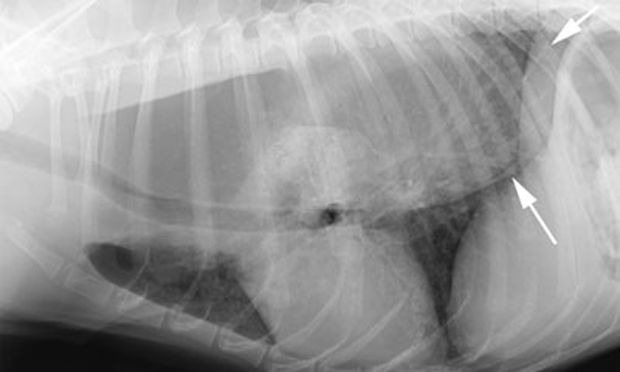Introduction
Dextrocardia refers to a rare congenital condition in dogs where the heart is located on the right side of the chest instead of the left side. This causes the heart to functionally be a mirror image and oriented to the right. The normal alignment and positioning of organs is known as situs solitus. In dextrocardia with situs solitus, the heart is reversed but the other organs maintain their normal positioning. This is different from situs inversus, where both the heart and other organs are reversed or mirrored from their normal anatomy.
Dextrocardia is caused by an abnormality during embryonic development which impacts proper orientation and sidedness. While the underlying cause is not fully understood, it results in the heart forming on the right side rather than the left. This reversal in cardiac anatomy is often asymptomatic, but can potentially lead to complications. Understanding dextrocardia and its implications is important for providing proper veterinary care for affected dogs.
Causes
Dextrocardia in dogs is caused by two main factors:
1. Congenital defect – Dextrocardia can occur as a result of abnormal embryonic development, where the heart forms on the right side instead of the left. This congenital defect happens early in gestation when the embryo’s internal organs are developing and rotating into position. A disruption in this process can lead to the heart ending up on the wrong side.1
2. Random gene mutation – In some cases, dextrocardia is caused by a spontaneous genetic mutation that occurs randomly as the embryo develops. This mutation affects genes that regulate left-right patterning and asymmetry in the body. The mutation causes the heart to develop on the opposite side from normal.2
Diagnosis
Dextrocardia can be diagnosed through several medical tests and exams. The main diagnostic methods include:
Physical exam
During a physical exam, the veterinarian will listen to the dog’s heart and lungs. In dogs with dextrocardia, the heart sounds will be louder on the right side of the chest rather than the left. The veterinarian may also feel an abnormal location of organs while palpating the abdomen (https://www.ncbi.nlm.nih.gov/pmc/articles/PMC9179193/).
X-rays
Chest x-rays will show the heart located on the right side of the chest cavity rather than the left. Abdominal x-rays can show reversal or displacement of other organs like the liver on the left side (http://www.veterinaryworld.org/Vol.5/June%202012/Dextrocardia%20and%20Situs%20inversus%20in%20a%20dog.pdf).

Ultrasound
An ultrasound allows visualization of the internal organs and can confirm dextrocardia with situs inversus. It shows the position and arrangement of the heart, liver, spleen and other organs (https://www.sciencedirect.com/topics/pharmacology-toxicology-and-pharmaceutical-science/dextrocardia).
Symptoms
Dextrocardia is often asymptomatic, meaning no symptoms are present (Isolated dextrocardia with situs solitus in a dog – case report). This congenital condition may be overlooked if it does not cause any noticeable health issues.
In some cases where the heart is positioned abnormally, dogs may experience exercise intolerance and shortness of breath (Miscellaneous Congenital Cardiac Abnormalities in Animals). The abnormal structure puts strain on the heart, limiting its pumping capacity during physical activity. Owners may notice their dog tiring more quickly or having difficulty breathing when active.

However, symptoms vary greatly depending on the type of structural defect present. Dextrocardia on its own does not necessarily cause significant impairments. But it can be associated with additional congenital heart issues that do result in more noticeable symptoms.
Treatment
Dextrocardia with situs solitus usually does not require treatment, as most dogs live normal lives without issues (Abreu, 2022). The condition is often discovered incidentally when dogs are brought in for unrelated reasons. However, any associated symptoms may require management.
In severe cases involving cardiac malformations, surgery may be necessary to correct structural defects. Procedures like septal defect closure and valve repair can be performed, but carrying out surgery on dextrocardia hearts requires specialized experience and equipment. Cardiac surgery and recovery tends to be more complicated than normal. Still, advancements in veterinary medicine make it possible to surgically manage certain defects. Close monitoring by a veterinary cardiologist is crucial before and after any surgical interventions (Merck Veterinary Manual).
Prognosis
The prognosis for dogs with dextrocardia depends on the severity and any other associated conditions. Isolated dextrocardia with situs solitus, where only the heart is in the right chest with normal arrangement of other organs, is often benign with a normal lifespan (de Abreu, 2022). However, dextrocardia associated with complex congenital heart defects carries a poorer prognosis.
One study found that dogs with situs inversus totalis, where all organs are mirrored, had a median survival time of 48 months when associated with subaortic stenosis (Piantedosi et al., 2011). With regular veterinary care and close monitoring, some dogs can live relatively normal lives with isolated dextrocardia. But complications like heart defects, primary ciliary dyskinesia, or other abnormalities will impact lifespan and require intensive management.
Lifestyle Changes
For dogs diagnosed with dextrocardia, some lifestyle changes may be necessary to support their overall heart health. According to the How to Keep Your Pet’s Heart Healthy article, depending on the condition of the heart, your dog may need adjustments such as decreased exercise or dietary changes.
Two key lifestyle changes to implement for a dog with dextrocardia are:
- Avoid strenuous exercise: Excessive physical activity can put strain on a dog’s heart, so eliminating strenuous exercise is often recommended. Low-impact activities like short walks are safer alternatives.
- Keep your dog cool in summer: Heat stress raises a dog’s heart rate, so cooling measures like air conditioning, shade, damp towels, and limited time outdoors are important in summer.

Making thoughtful lifestyle adjustments enables dogs with dextrocardia to avoid overtaxing their hearts while still enjoying daily life. Consult with your veterinarian to develop the best plan for your dog’s needs.
Prevention
Since dextrocardia is a congenital condition that occurs during fetal development, there are no specific prevention methods. It happens randomly due to abnormal positioning of the heart tube during the fourth week of embryonic development. The causes are often unknown. Some potential factors that may interfere with normal heart positioning and development include:
- Genetic or chromosomal abnormalities
- Maternal illness during pregnancy
- Exposure to toxins or medications that impact development
While expectant mothers can focus on maintaining good health and avoiding risky exposures, dextrocardia cannot be prevented through prenatal care. It occurs due to developmental factors out of parental control. The best approach is early detection through fetal ultrasound and echocardiography so that any accompanying heart defects can be evaluated and managed after birth if needed.
Outlook
Despite having a heart on the opposite side, most dogs born with dextrocardia can live relatively normal lives with proper care. The condition does not inherently affect lifespan or quality of life. With appropriate monitoring and treatment when necessary, dogs with dextrocardia have similar longevity compared to other dogs.
Some dogs may require medications or changes to diet and exercise routines, especially if there are accompanying heart defects. But the outlook is generally positive. Your veterinarian will work with you to create an individualized treatment plan to keep your dog healthy and comfortable.

With dedication to routine vet visits, monitoring, and following your vet’s recommendations, dogs with dextrocardia can enjoy many happy and active years as loving family pets. While the condition requires extra attention, it does not prevent dogs from living fulfilling lives.
Summary
In this article, we discussed dextrocardia in dogs, which is when a dog’s heart is on the right side instead of the left. We covered the causes, symptoms, diagnosis, treatment, and prognosis. Some key takeaways:
- Dextrocardia in dogs can be an isolated condition or associated with other defects.
- Symptoms often involve exercise intolerance, rapid breathing, coughing, weakness.
- Diagnostic methods include x-rays, ECG, ultrasound.
- There is no cure but treatments focus on managing symptoms and associated defects.
- With proper care, dogs with dextrocardia can live fairly normal lives.
While having the heart on the wrong side is alarming, with veterinary attention dogs can still live happily and healthily. Being aware of the signs and prompt diagnosis is key.